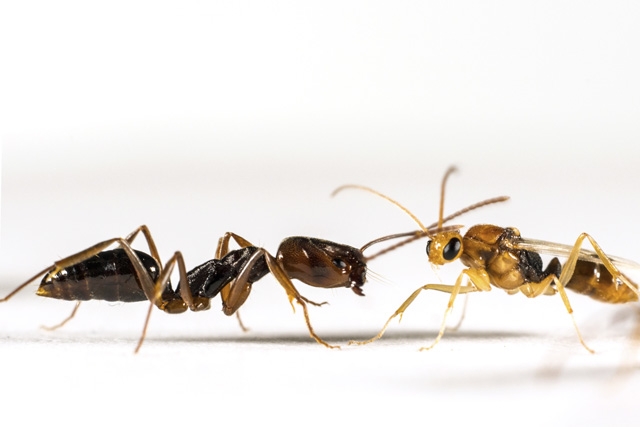Mixed signals: study finds insect species use very different chemicals to identify queens
For immediate release ‐ February 04, 2016
Contact: Adrian Smith, 919.707.8095 and Matt Shipman, 919.515.6386. Images available upon request

A worker (left) and male of the trapjaw ant species Odontomachus ruginodis. Photo credit: Adrian Smith.
It had been thought that all ants, wasps and other eusocial insects used a common class of chemical compounds to distinguish queens from workers and other members of their colonies or hives. But new research finds that there is significant variation in these chemical signals, even between closely related species. The work was done by scientists at North Carolina State University, the North Carolina Museum of Natural Sciences, the University of California, Riverside, and the University of Illinois at Urbana-Champaign.
“These chemical signatures are incredibly important, because social insect groups couldn’t function without them,” says Adrian Smith, lead author of a paper on the work, an assistant research professor of biological sciences at NC State and head of the NC Museum of Natural Sciences’ Evolutionary Biology & Behavior Research Lab. “These signals are how insects in a colony distinguish males from females and workers from queens.”
Researchers collected the colonies of three closely related trap-jaw ant species found in the southeastern United States: Odontomachus ruginodis, O. relictus and O. haematodus. The researchers then took samples of the chemicals found on the cuticle – or exoskeleton – of each colony’s queen and workers and used a gas chromatograph to analyze each ant’s chemical signature.
The researchers found that the queens of each trap-jaw species used very different chemicals to differentiate themselves from workers.
“Not only are these pheromones outside of the class of compounds thought to be common to all eusocial insect queens, but they are not even similar to each other,” Smith says. “Each species uses its own unique blend of chemicals. And two of these chemicals are – as far as we can tell – completely new to science.”
These new chemicals belong to a class of compounds called dialkyltetrahydrofurans, which had previously been found in butterflies, but not in other eusocial insect species.
Queen and worker ants are all females, but the researchers also sampled the chemicals found on males.
“Across these three Odontomachus species, the males had much more similar chemical signatures than females – though you could still tell one species from another,” Smith says.
“Males are outsiders in ant society – they fly out of the colony to breed and then die,” Smith says. “Perhaps because of this, they are not well studied. Little is known about their chemical signatures, even though these male pheromones may play a key role in how prospective queens identify their mates.”
The new findings raise interesting questions in two areas. One question is: Are these results evidence of evolutionary links between solitary and social insect communication?
“Solitary insects use their chemical signatures for distinguishing the sexes and finding a mate,” Smith says. “This study demonstrates that social insects are likely doing the same thing, as well as things that are specific to social insects, such as queen signaling.”
Another line of questioning revolves around the new chemical compounds that researchers found in Odontomachus queens. Additional research is needed to explore why the ants have evolved to produce these chemicals, and whether these chemicals may have practical uses in other applications.
The paper, “Comparative analysis of fertility signals and sex-specific cuticular 1 chemical profiles of Odontomachus trap-jaw ants,” is published in the Journal of Experimental Biology. The paper was co-authored by Jocelyn Millar of UC Riverside and Andrew Suarez of Illinois. A video explaining the work is below.
-shipman-
Note to Editors: The study abstract follows.
“Comparative analysis of fertility signals and sex-specific cuticular 1 chemical profiles of Odontomachus trap-jaw ants”
Authors: Adrian A. Smith, North Carolina State University and the North Carolina Museum of Natural Sciences; Jocelyn G. Millar, the University of California, Riverside; and Andrew V. Suarez, the University of Illinois at Urbana-Champaign
Published: Feb. 3, Journal of Experimental Biology
DOI: 10.1242/jeb.128850
Abstract: The mixture of lipids that coat the insect cuticle contain a number of chemical signals. Mate choice in many solitary insects is mediated by sexually dimorphic cuticular chemistry, whereas in eusocial insects, these profiles provide information through which colony members are identified and the fertility status of individuals is assessed. Profiles of queens and workers have been described for a number of eusocial species, but there have been few comparisons of fertility signals among closely related species. Additionally, sexual dimorphism in cuticular lipid profiles has only been reported in two species of ants. This study describes the cuticular chemical profiles of queens, workers, and males of three species of Odontomachustrap-jaw ants: O. ruginodis, O. relictus, and O. haematodus. These are compared to fertility signals and sexually dimorphic profiles already described from O. brunneus. We report that fertility signals are not conserved within this genus: chemical compounds that distinguish queens from workers vary in number and type among the species. Furthermore, the compounds that were most abundant in cuticular extracts of O. ruginodis queens relative to workers were identified as novel 2,5-dialkyltetrahydrofurans. Bioassays of extracts of O. ruginodis queens indicate that the dialkyltetrahydrofuran and hydrocarbon fractions of the profile are likely to work synergistically in eliciting behavioral responses from workers. In contrast, the cuticular lipids that distinguish males from females were more conserved across species, with isomeric and relative abundance variations comprising the main differences among species. Our results provide new insights into how these contact chemical signals may have arisen and evolved within eusocial insects.

